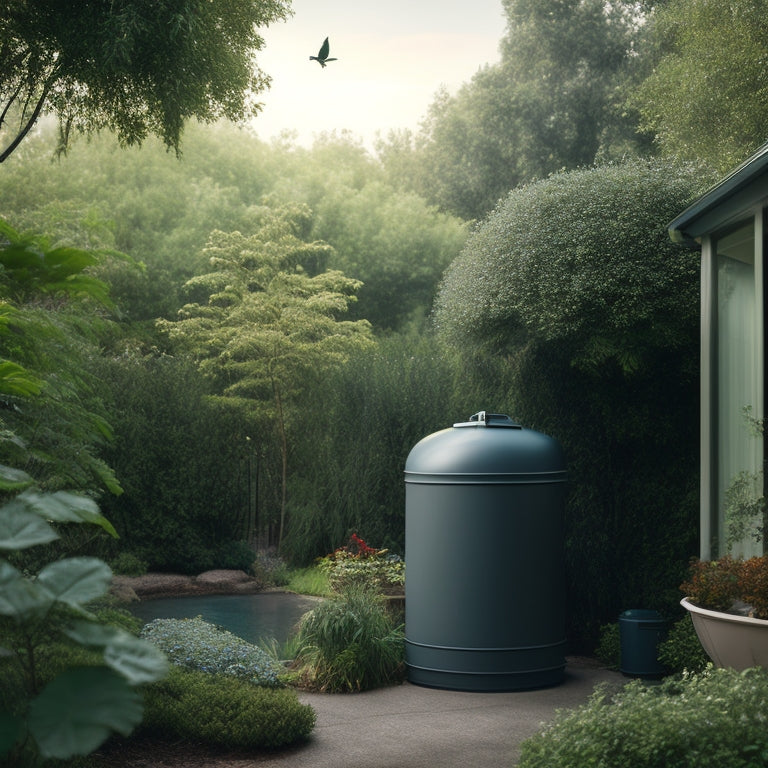
Eco-Friendly Home Rainwater Collection: A Comprehensive Guide
Share
You're taking an essential step towards embracing a more sustainable lifestyle by investing in eco-friendly home rainwater collection, a practice that can notably reduce your reliance on municipal water supplies and lower your carbon footprint. By capturing rainwater, you'll enjoy benefits like reduced water bills, increased water independence, and a lower risk of waterborne diseases. To get started, you'll need to take into account factors like collection system components, storage tank installation, filtration methods, and water distribution systems. As you investigate the ins and outs of rainwater gathering, you'll gain a deeper understanding of how to create a system that's customized to your unique needs and maximizes its eco-friendly potential.
Key Takeaways
- Implementing a rainwater harvesting system reduces reliance on municipal water supplies and lowers water bills.
- A well-designed collection system includes a roof catchment, gutters, conveyance system, first flush device, and optimal solar panel design.
- Storage tanks must be durable, resistant to corrosion, and suitable for potable water storage, with proper sizing essential for efficiency.
- Effective filtration methods, such as gravity filtration, sand filters, cartridge filters, and UV filters, ensure harvested rainwater is clean and safe for use.
- Regular maintenance, including roof and gutter maintenance, tank and pipe inspection, and water quality testing, is crucial for optimal system performance and longevity.
Understanding Rainwater Harvesting Basics
Rainwater harvesting is a practice that involves collecting and storing rainwater for later use, reducing your reliance on municipal water supplies and decreasing stormwater runoff. By doing so, you can enjoy several rainwater benefits, such as reduced water bills, increased water independence, and a lower carbon footprint.
Furthermore, rainwater harvesting helps to decrease the burden on municipal water treatment systems and reduces the risk of waterborne diseases. Additionally, incorporating renewable energy solutions, such as solar energy implementation, can further enhance the sustainability of your rainwater harvesting system. Similarly, reflecting on the use of biodiesel fuel systems can also contribute to a cleaner and more sustainable water management approach.
However, it's crucial to take into account legal considerations before implementing a rainwater harvesting system. Check with local authorities to guarantee compliance with regulations and ordinances governing rainwater collection.
Additionally, consult with local experts to determine the feasibility of rainwater harvesting in your area.
Selecting the Right Collection System
- Roof catchment: This is the surface area where rainwater is collected, typically your home's roof.
When designing your rainwater collection system, it's crucial to evaluate the optimal solar panel array design Optimize Your Solar Panel Array to guarantee maximum energy production, which can be applied to power your system.
-
Gutters and downspouts: These channels direct rainwater from the roof to the storage tank.
-
Conveyance system: This transports rainwater from the gutters to the storage tank, which can be a gravity system or employ pump options.
-
First flush device: This component allows the first flow of water from the roof to be diverted, taking any debris and contaminants with it, and then allows clean water to flow into the storage tank.
Installing Rainwater Storage Tanks
With your collection system designed, attention turns to installing rainwater storage tanks, an essential component for holding harvested water.
You'll need to take into account local rainwater regulations, which may dictate tank size, material, and installation requirements.
When selecting a tank material, think about eco-friendly options like those made from renewable energy sources to reduce your carbon footprint.
Choose tank materials that are durable, resistant to corrosion, and suitable for potable water storage, such as stainless steel, concrete, or polyethylene.
Confirm the tank is sized appropriately for your collection system and intended water usage.
Proper installation is vital, so contemplate hiring a professional or following manufacturer instructions carefully.
The tank's location should be easily accessible for maintenance and inspection, and protected from direct sunlight, extreme temperatures, and physical damage.
Choosing Effective Filtration Methods
Your newly installed storage tank is now ready to hold harvested rainwater, but before you can use it, you'll need to confirm the water is clean and free of contaminants.
To ascertain the water is safe for use, you'll need to implement an effective filtration system. As with commercial solar charging systems, on-site energy generation allows for better control over energy costs and reduces reliance on traditional power sources solar-powered solutions.
Effective filtration methods can considerably lower operational costs and improve energy efficiency.
-
Gravity Filtration: A cost-effective method that uses gravity to filter out debris and contaminants, providing a reliable and low-maintenance solution.
-
Sand Filters: A popular choice for rainwater harvesting systems, sand filters remove suspended solids and sediment, guaranteeing your water is clear and clean.
-
Cartridge Filters: These filters use replaceable cartridges to remove impurities, offering a convenient and effective solution for smaller systems.
- Ultraviolet (UV) Filters: Ideal for systems that require disinfection, UV filters use light to kill bacteria and other microorganisms, providing an additional layer of protection.
Implementing Water Distribution Systems
You'll need to design a reliable water distribution system to transport rainwater from storage to points of use. This involves selecting suitable piping and fittings, choosing the right water storage options, and installing distribution valves that control water flow.
Additionally, regular maintenance, including cleaning, is essential for peak system performance and energy efficiency solar panel performance.
Piping and Fittings
Implementing a water distribution system is an essential step in rainwater collection, as it allows you to transport and employ the harvested water efficiently.
When it comes to piping and fittings, you'll need to choose the right materials and components for your system.
- Select piping materials that are resistant to corrosion and UV degradation, such as PVC, HDPE, or PEX.
- Consider fitting types that are easy to install and maintain, like push-fit or compression fittings.
- Confirm your piping and fittings are compatible with your system's water pressure and flow rate.
- Don't forget to include valves and filters to control water flow and quality.
Water Storage Options
Once the piping and fittings are in place, the next step is to determine how to store the collected rainwater.
You'll want to choose a storage option that maximizes the rainwater benefits while minimizing environmental impact. You have two main options: above-ground or below-ground storage tanks.
Above-ground tanks are more cost-effective and easier to install, but they may not be aesthetically pleasing. Below-ground tanks, on the other hand, are more discreet but require more extensive installation.
Consider factors like tank material, size, and durability when making your decision. Verify your chosen tank is food-grade, UV-resistant, and suitable for potable water storage.
Distribution Valve Types
Configure your rainwater distribution system with the right valves to guarantee efficient water flow and pressure.
You'll need valves that can handle the demands of your system, whether it's a gravity feed or pressure system.
-
Ball valves are ideal for shut-off applications, allowing you to isolate parts of the system for maintenance or repairs.
-
Gate valves provide precise control over water flow and are often used in larger systems.
-
Butterfly valves offer a compact design and are suitable for smaller systems.
- Check valves make certain water flows in one direction, preventing backflow and contamination.
Maintaining Your Rainwater Harvesting
You've invested time and resources into setting up your rainwater harvesting system, and now it's vital to maintain it to guarantee peak performance and longevity.
Regular maintenance guarantees rainwater quality remains high and your system operates efficiently. Create a maintenance schedule to inspect your system quarterly, checking for debris, corrosion, and signs of wear.
Clean the roof catchment and gutters regularly to prevent sediment buildup. Check the first flush device and verify it's functioning correctly.
Inspect the tank and pipes for cracks, corrosion, or blockages. Perform water quality tests periodically to identify any contamination issues.
Frequently Asked Questions
Can I Use Rainwater for Drinking and Cooking?
You can use rainwater for drinking and cooking, but only after proper water purification and implementing effective filtration methods to remove contaminants, ensuring the water meets safety standards for human consumption.
Is Rainwater Harvesting Legal in My Area?
As you stand beneath the pouring sky, enthusiastic to utilize nature's bounty, you wonder: are you free to collect rainwater in your area? Check local rainwater regulations and guidelines to confirm you're not pouring your efforts down the drain.
How Often Should I Clean My Gutters and Downspouts?
You should clean your gutters at least twice a year, and after heavy storms, to guarantee proper gutter maintenance. Additionally, consider a downspout design with built-in filters or screens to reduce debris accumulation and minimize cleaning frequency.
Can I Connect My Rainwater System to a Well?
Imagine a seamless fusion of nature's gift and your well's reliability. You can connect your rainwater system to a well, but guarantee proper rainwater filtration and regular system maintenance to avoid contamination and secure a harmonious, self-sufficient water supply.
Do I Need a Permit to Install a Rainwater Collection System?
You'll likely need to check with local authorities to determine if a permit is required for your rainwater system installation, as rainwater system regulations and installation requirements vary by region and municipality.
Related Posts
-

What Cool Roof Tax Breaks Can Homeowners Claim?
You can claim federal tax credits of up to $500 and state and local incentives for installing cool roofs, which not o...
-

10 Grid-Tied Wind Power Systems for Modern Homes
You're looking for a grid-tied wind power system to utilize wind energy for your modern home. Here are ten options to...
-

3 Eco-Friendly Automated Blinds for Contemporary Living
You're looking to raise your living space with automated blinds that not only exude contemporary style but also align...


